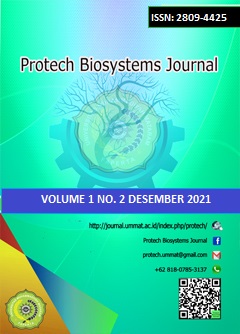Study Of The Effectiveness Of Drip Irrigation Techniques On The Use Of Diferent Mulse In Dry Land Tomato Cultivation
DOI:
https://doi.org/10.31764/protech.v1i2.6801Keywords:
Drip Irrigation, Straw, Dry Land, Mulch, TomatoesAbstract
In order to meet the water needs of tomato plants and ensure that they grow well, an adequate irrigation water supply systems that are ideal for tomato plans. This analysis aims to 1] determine the effectiveness of drip irrigation techniques on tomato plant growth on dry land, and 2] assess the impact of drip irrigation techniques on plots given silver and straw plastic mulch, as well as properties without both. This research used an experimental apporoach that included both field and laboratory experiments. A one-factor randomized blog design (RBD) was used in this analysis, with three treatments: P1 = no mulch and straw, P2 = silver color plastic mulch, and P3= straw. The least significant difference method (LSD) was evaluated at the 5% actual level using SPSS analysis. Observation data were analyzed using two apporoaches: a mathematical apporoach using Microsoft excel and statical analysis using ANOVA analysis. The serults showed that the parameters of plant height, stem diameter, and the number of leaves of tomato plants had a significant impact on P1 ( no mulch and straw), P2 ( Silver Color Plastic Mulch), and P3 (Silverr Color Plastic mulch) (straw). It applied drip irrigation techniques to the growth of tomato plants in dryland. Although tomato plant wet weight and tomato plant dry weight parameters had a significant impact on tomato  plant growth and dry weight than P1 and P3. It results in an average wet weight of 162.678 grams, P1 24.05 grams, P3 81.10 grams, and an average dry weight of 31.62 grams, P1 5.84 grams P3 18.74 gram, respectively.
References
Doring T., Udo Heimbach, Thomas Thieme, Maria Finckch, and Helmut Saucke, 2006. Aspect Of Straw Mulching In Organic Potatoes-I, Effects On Microclimate, Phytophtora Infestans, And Rhizoctonia Solani. Nachrichtenbl.Deut. Pflanzenschutzd. 58 (3):73-78.
Dwidjoseputro, D., 1994. Dasar-Dasar Mikrobiologi. Jakarta: Djambatan. Halaman 6.
Firmansyah, I., Syakir, M., dan Lukman, L., 2017. Pengaruh Kombinasi Dosis Pupuk N, P, dan K Terhadap Pertumbuhan dan Hasil Tanaman Terung (Solanum melongena L.). Jurnal Hortikultura, 27(1), 69–78. https://doi.org/10.21082/jhort.v27n1.2017.p69-78.
Fisher, A.R., 1935. The Design Of Experiment. Edinburgh: Oliver And Boyd.
Lutfhi Triansyah. 2019.Manfaat Mulsa Plastik Untuk Tanaman. PPL Kec.Kandis Kab.Ogan Ilir.
Kadarso, 2008. Kajian Penggunaan Jenis Mulsa Terhadap Hasil Tanaman Cabai Merah Varietas Red Charm. Agros. 10(2) : 134-139.
Kasiran, 2006. Teknologi Irigasi Tetes “Ro Drip†untuk Budidaya Tanaman Sayuran di Lahan Kering Dataran Rendah. Jurnal Sains dan Teknologi Indonesia. Vol. 8 (1) : 26-30.
Krishnappa, A. M., Y. S. Arun Kumar, Murukannappa, and B. R. Hedge, 1999. Improve in situ moisture conservation practises for stabilized crop yield in drylands. In Singh et al. (eds.). Fifty Years of Dryland Agricultural Research in India. Central Research Institut for Dryland Agriculture. Santoshnagar, Hyderabad – 500 059.
Muanah, Karyanik, dan Romansyah, E., 2020. Rancang Bangun dan Uji Kinerja Penerapan Teknik Irigasi Tetes Pada Lahan Kering. Jurnal AGROTEK vVol.7, No.2.
Noorhadi dan Supriyadi, 2003. Pengaruh Pemberian Air dan Mulsa terhadap Iklim Mikro pada Tanaman Cabai (Capsicum annum L) di Tanah Entisol. Sains Tanah. 3 (2):68-72.
Purwanto dan Ikhsan, J., 2013.‘Analisis Kebutuhan Air Irigasi pada Daerah Irigasi Bendung Mrican1’. Jurnal Ilmiah Semesta Teknika.
Pusat Data dan Sistem Informasi Pertanian, 2017. Outlook komoditas tanaman pangan dan holtikultura. Indonesia.
Retno dan Darminanti S., 2009. Pengaruh Dosis Kompos Dengan Stimulator Tricoderma Terhadap Pertumbuhan dan Produksi Tanaman Jagung (Zea Mays L.).Varietas pioner – 11 Pada Lahan Kering. Jurnal BIOMA. Vol . 11. No 2. Hal 69 -75.
Rismaneswati. 2006. Pengaruh Terracottem, Kompos dan Mulsa Jerami terhadap Sifat Fisik Tanah. Pertumbuhan dan Produksi Kedelai pada Tanah Alfisols. JurnalAgrivigor 6 (1): 49-56.
Ristaino, C. Tu, J. B. dan S. Hu, 2010 “Soil microbial biomass and activity in organic tomato farming systems: effects of organic inputs and straw mulchingâ€, Soil Biology & Biochemistry Journal, Vol. 38, Issue 2, hal. 247-255.
Rofidah, N. I., Yulianah, I., dan Respatijarti, 2018. Korelasi Antara Komponen Hasil Dengan Hasil Pada Populasi F6 Tanaman Cabai Merah Besar ( Capsicum annuum L .). Jurnal Produksi Tanaman, 6(2), 230–235.
Selvamurugan, M., I. chamy, V. Navaneetha Pandian and M. Manikandan, 2018. Effect of drip fertigation and plastic mulching on growth and yield of tomato. Journal of Applied Horticulture. Doi: https://doi.org/10.37855/jah.2018.v20i01.14.
Tala’ohu, S.H., Sutono, S., dan Soelaeman, Y., 2003. Peningkatan produktivitas lahan kering masam melalui penerapan teknologi konservasi tanah dan air. (Prosiding).Simposium Nasional Pendayagunaan Tanah Masam, Buku II, Bandarlampung, Puslitbangtanak. 24 November 2020.
Tugiyono, H., 2005. Bertanam Tomat. Penebar Swadaya. Jakarta.
Wijayani, A., dan W. Widodo, 2005. Usaha Meningkatkan Kualitas Beberapa Varietas Tomat Dengan Sistem Budidaya Hidroponik. Jurnal Ilmu Pertanian. Vol. 12(!): 77-83.
Downloads
Published
Issue
Section
License
Authors who publish articles in Protech Biosystems Journal agree to the following terms:
- Authors retain copyright of the article and grant the journal right of first publication with the work simultaneously licensed under a CC-BY-SA or The Creative Commons Attribution–ShareAlike License.
- Authors are able to enter into separate, additional contractual arrangements for the non-exclusive distribution of the journal's published version of the work (e.g., post it to an institutional repository or publish it in a book), with an acknowledgment of its initial publication in this journal.
- Authors are permitted and encouraged to post their work online (e.g., in institutional repositories or on their website) prior to and during the submission process, as it can lead to productive exchanges, as well as earlier and greater citation of published work (See The Effect of Open Access).

